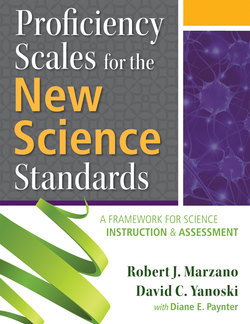Читать книгу Proficiency Scales for the New Science Standards - Robert J Marzano - Страница 4
ОглавлениеTable of Contents
Part I: Applying the New Science Standards
1 The Evolution of Standards-Based Education in Science
The Next Generation Science Standards Initiative
The Influence of the NRC Framework
2 Measurement Topics, Proficiency Scales, and the NGSS
The Nature of Proficiency Scales
Proficiency Scales Organized Into Measurement Topics
Defining Features of Proficiency Scales
Developing More Complex (Score 4. 0) Learning Goals
Summary
3 Proficiency Scales and Classroom Instruction
Three Types of Lessons
Instructional Strategies That Commonly Appear During All Types of Lessons
Strategies That Set an Effective Context for Learning
Planning for Daily Lessons
Teaching the Scientific and Engineering Practices
Summary
4 Proficiency Scales and Classroom Assessment
Test Design
Whole-Class Assessments
Individual Student Assessments
Creating Common Assessments Using Proficiency Scales
Recording Student Progress on Measurement Topics
Grading and Reporting With Proficiency Scales
Conclusion
Part II: Scoring the New Science Standards
Proficiency Scales for the Next Generation Science Standards
Forces and Interactions
Electric and Magnetic Forces
Gravity
Energy and Forces
Energy Definitions
Energy Conservation and Energy Transfer
Waves
Electromagnetic Radiation
Information Technologies
States of Matter
Structure and Properties of Matter
Conservation of Matter
Chemical Reactions
Bonds
Nuclear Processes
Growth and Development of Organisms
Matter and Energy in Organisms
Ecosystem Dynamics
Interdependent Relationships in Ecosystems
Matter and Energy in Ecosystems
Humans, Biodiversity, and Ecosystems
Structure and Function
Information Processing
Cell Theory
Inheritance of Traits
Variation of Traits
Adaptation
Natural Selection
Fossils
Evidence of Common Ancestry
The Solar System
The Universe and Stars
Weather and Climate
Natural Hazards
Weathering and Erosion
Water and Earth’s Surface
Earth’s History
Plate Tectonics
Earth Systems
Humans and Earth Systems
Biogeology
Natural Resources
Global Climate Change
Carbon Cycle
Defining Problems
Designing Solutions
Evaluating and Testing Solutions
Appendix A: Using the New Taxonomy of Educational Objectives
Level 1 (Retrieval)
Level 2 (Comprehension)
Level 3 (Analysis)
Level 4 (Knowledge Utilization)
Appendix B: Strategies for Setting an Effective Context for Learning
Engagement
Rules and Procedures
Relationships
Communicating High Expectations
